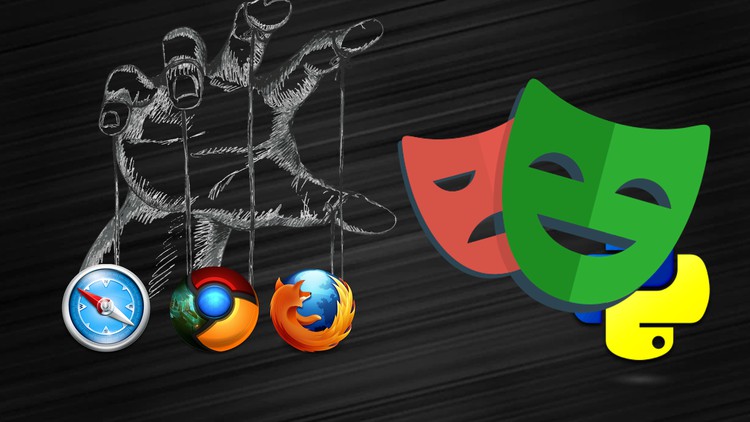
Learn to Create Automation Test Cases from Scratch with Playwright and PyTest
What you will learn
Complete automation test cases by integrating Playwright and PyTest
Learn how to use Playwright code generator and interactive mode
Explore Playwright Trace Viewer
Learn command line arguments with Playwright
Add custom viewpoint sizes and device emulations
Debug test cases
Master API Testing
Learn Playwright assertions and authentications
Test downloads, uploads, events and frames
Learn automation testing for networks
Use playwright to make videos and reports of your test cases
Description
This course will teach you the fastest emerging automation testing tool Playwright. It is an open-source test automation library initially developed by Microsoft contributors. Microsoft Playwright is a cross-browser automation library for end-to-end testing. The goal of Playwright is to provide a single API to developers and testers to automate their web applications across today’s three major browser engines: Mozilla Firefox and WebKit. It’s easy to set up, feature-packed, and the fastest, most reliable frameworks available.
This course will teach you a unique technique for integration between Playwright and PyTest.
This course will teach you how to use Microsoft Playwright with plenty of examples and individual projects. Playwright provides a Pytest plugin to write end-to-end tests. You will learn how to integrate Playwright with PyTest and Python to generate robust automation tests for your application. Here you will learn by doing.
Teaching Material
- Section 4: The section covers the very basics of Playwright installation, environment set-up and plugins. You will see where Playwright stands in the industry and among the rest of the software test automation tools.
- Section 5: You will learn the complete Playwright tools kit. You will learn the Playwright debugging tools and how to autogenerate test scripts, test reports screenshots and even videos of your running test cases.
- Section 6: You will learn how to create stand alone test cases by integrating PyTest and Playwright. You will conduct tests of on a very popular web pages such as: Google, YouTube and Wikipedia.
- Section 7: Once you get used to the test case development we will start building API tests. Here you will learn how to test Authentication, Downloads, Emulations and Dialogs.
- Section 8: You will explore with testing Frames and Networks. You will learn to use to use playwright Locators and Handlers. They will help you to automatically write into fields, selecting or deselecting radio buttons and executing http requests.
- Section 9: You will go to Automation Playground: a web page specifically created to test your automation testing skills. There you will use playwright to exercise clicks, scrollbars, verifications, delays, layers and many more.
- Section 10: You will finish this course by developing a complete playwright test projects. You will be able to use your skills to test GitHub project management page using everything you have learned from the course. You will be asked to automatically register and authenticate a user, create branches and tickets and manage them.
Playwright Advantages
- Easy Setup and Configuration: Being a Test Automation Framework, it just needs a configuration as the installation doesn’t take much time. Depending on the language we use with Playwright, the installation steps might change
- Multi-Browser Support: Chromium family browsers (Chrome, Edge), Webkit (Safari), and Firefox are all supported.
- Multi-Language Support: Playwright supports Java, C#, Python, Javascript/ Typescript making it a popular choice. Most of the modern open-source test automation frameworks miss this feature.
- Types of Testing: Playwright supports Functional, End to End, and API Testing. With a Third-party plugin, Playwright can be integrated with Accessibility Testing
- Parallel Browser Testing: Playwright also supports the execution of simultaneous tests through Browser Context and can run parallel tests with multiple browsers. This scales up testing and comes in handy when multiple web pages have to be tested simultaneously.
- Support for Multiple Tab/Browser Window: Playwright supports multi-tab and multi-window. Some test cases need to verify the scenario by launching a new window and returning to the parent window. Playwright supports all different types of test cases.
- Built-in Reporters: Playwright framework, by default, comes with a lot of valuable reporters like List, Dot, Line, JSON, JUnit, and HTML Reporters. The exciting part is that with Playwright, one can create custom reporters. Playwright also supports third-party reporter Allure Report.
- Typescript Support out of the box: Zero configuration is required for typescript language support as it understands your typescript and javascript code.
- CI/CD Integration Support: Playwright supports CI/CD integration. It even provides docker images for some language bindings.
- Debugging Tools Support: Playwright provides many different debugging options making it developer-friendly. Some debugging options are Playwright Inspector, VSCode Debugger, Browser Developer Tools, and Trace Viewers Console Logs.
Content
Introduction
Software Installations
Python Basics
PyTest Basics
Get Started with Playwright
Playwright Tools
Playwright and PyTest Integration
Playwright API Testing, Browsers and Assertions
Playwright Pages Selection and Handlers